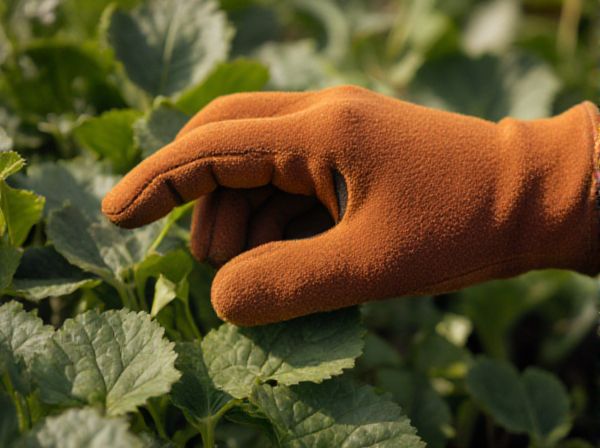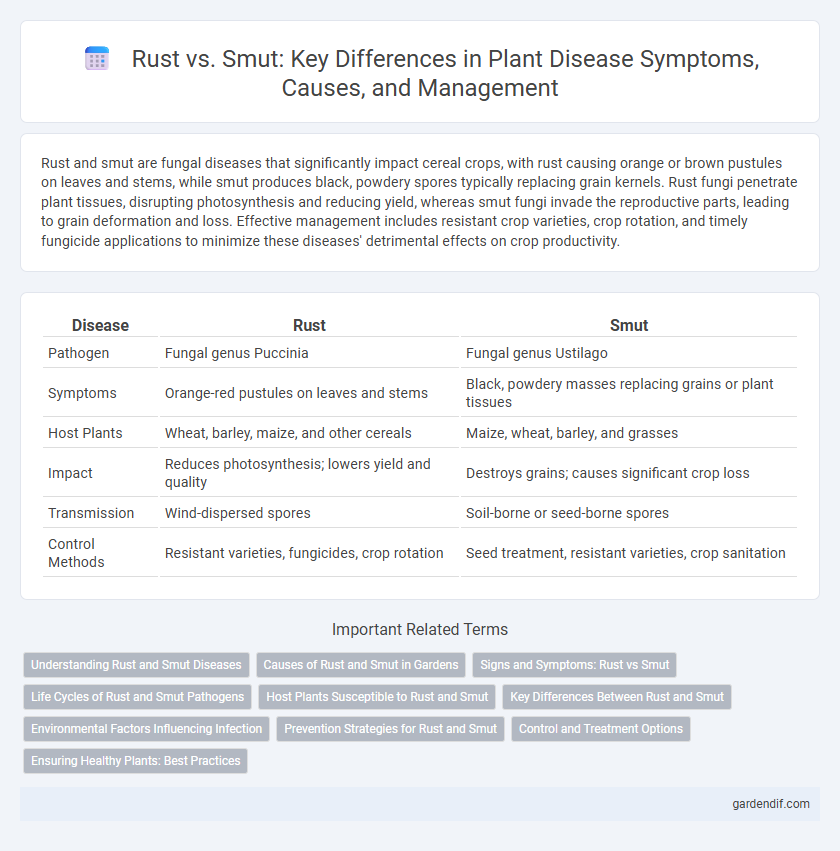
Rust vs Smut Illustration
Rust and smut are fungal diseases that significantly impact cereal crops, with rust causing orange or brown pustules on leaves and stems, while smut produces black, powdery spores typically replacing grain kernels. Rust fungi penetrate plant tissues, disrupting photosynthesis and reducing yield, whereas smut fungi invade the reproductive parts, leading to grain deformation and loss. Effective management includes resistant crop varieties, crop rotation, and timely fungicide applications to minimize these diseases' detrimental effects on crop productivity.
Table of Comparison
| Disease | Rust | Smut |
|---|---|---|
| Pathogen | Fungal genus Puccinia | Fungal genus Ustilago |
| Symptoms | Orange-red pustules on leaves and stems | Black, powdery masses replacing grains or plant tissues |
| Host Plants | Wheat, barley, maize, and other cereals | Maize, wheat, barley, and grasses |
| Impact | Reduces photosynthesis; lowers yield and quality | Destroys grains; causes significant crop loss |
| Transmission | Wind-dispersed spores | Soil-borne or seed-borne spores |
| Control Methods | Resistant varieties, fungicides, crop rotation | Seed treatment, resistant varieties, crop sanitation |
Understanding Rust and Smut Diseases
Rust and smut are fungal diseases that affect crops, with rust caused by various Puccinia species and smut caused by fungi in the Ustilaginomycetes class. Rust manifests as orange or reddish pustules on leaves and stems, reducing photosynthesis and crop yields, while smut produces black, powdery spore masses that replace grains or plant tissues, severely impacting grain quality. Effective management requires accurate identification, resistant crop varieties, and timely fungicide application to minimize economic losses.
Causes of Rust and Smut in Gardens
Rust in gardens is primarily caused by fungal pathogens from the Puccinia and Uromyces genera, which thrive in warm, humid conditions and infect plants by producing spores that spread through wind and water. Smut diseases are caused by fungi in the Ustilago and Tilletia genera, often affecting grasses and cereals by infiltrating plant tissues and forming black, powdery spore masses. Both rust and smut infections result from fungal spores landing on susceptible hosts, with environmental factors like moisture levels and temperature playing crucial roles in their development.
Signs and Symptoms: Rust vs Smut
Rust disease manifests as small, powdery pustules that are orange, reddish, or brown, typically appearing on the undersides of leaves, causing yellowing and premature leaf drop. Smut is characterized by large, swollen galls or black, powdery spore masses replacing kernels or plant tissues, often leading to distorted growth and reduced yield. Both diseases impair photosynthesis and crop productivity but differ in their symptom presentation and affected plant parts.
Life Cycles of Rust and Smut Pathogens
Rust pathogens exhibit complex life cycles often involving up to five distinct spore stages and frequently require two different host species for completion, enabling extensive genetic recombination and spread. Smut pathogens have simpler life cycles, primarily producing teliospores that germinate to form infectious basidiospores, typically infecting a single host species and relying on systemic infection mechanisms. Understanding these life cycle differences is crucial for developing targeted disease management strategies in cereals and other crops affected by rust and smut fungi.
Host Plants Susceptible to Rust and Smut
Rust primarily affects cereal crops such as wheat, barley, and oats, while smut targets maize, barley, and wheat among host plants. Rust fungi belong to the Pucciniales order, causing pustules on leaves and stems that reduce photosynthesis and yield. Smut diseases, caused by fungi in the Ustilaginomycetes class, produce black, powdery spores replacing grain or floral tissues in susceptible crops.
Key Differences Between Rust and Smut
Rust presents as orange to brownish pustules primarily on leaves and stems caused by fungal pathogens in the Pucciniales order, whereas smut manifests as black, powdery spore masses on grain heads and stems, typically due to Ustilaginomycetes fungi. Rust infections often result in pustule formation disrupting photosynthesis, while smut replaces normal plant tissues with dark spores that reduce grain quality and yield. Rust fungi generally require alternate hosts to complete their lifecycle, contrasting with smut fungi that complete their lifecycle on a single host plant.
Environmental Factors Influencing Infection
Rust and smut diseases in plants are significantly influenced by environmental factors such as temperature, humidity, and rainfall patterns. Rust fungi thrive in warm, moist conditions with frequent leaf wetness, which facilitates spore germination and infection. In contrast, smut pathogens favor high humidity combined with moderate temperatures, creating an optimal environment for spore development and plant tissue colonization.
Prevention Strategies for Rust and Smut
Effective prevention strategies for rust include planting resistant crop varieties, maintaining proper field sanitation to reduce inoculum sources, and applying appropriate fungicides at critical growth stages. For smut control, using certified disease-free seeds, crop rotation with non-host plants, and seed treatments with systemic fungicides are essential. Timely monitoring and integrated disease management enhance prevention, reducing yield losses caused by rust and smut infections.
Control and Treatment Options
Control measures for rust diseases primarily involve the use of resistant plant varieties and timely fungicide applications targeting the Puccinia fungal species. Smut diseases are managed through seed treatments with systemic fungicides and crop rotation to reduce fungal inoculum of Ustilago species. Both diseases benefit from integrated pest management strategies integrating cultural practices and chemical controls to minimize yield losses.
Ensuring Healthy Plants: Best Practices
Rust and smut are fungal diseases that severely impact crop yields, necessitating vigilant disease management to ensure healthy plants. Implementing crop rotation, using resistant plant varieties, and applying appropriate fungicides effectively reduce infection risks for both rust and smut pathogens. Regular field inspections combined with proper sanitation practices help in early detection and containment, maintaining overall plant health and productivity.
Rust vs Smut Infographic

 gardendif.com
gardendif.com